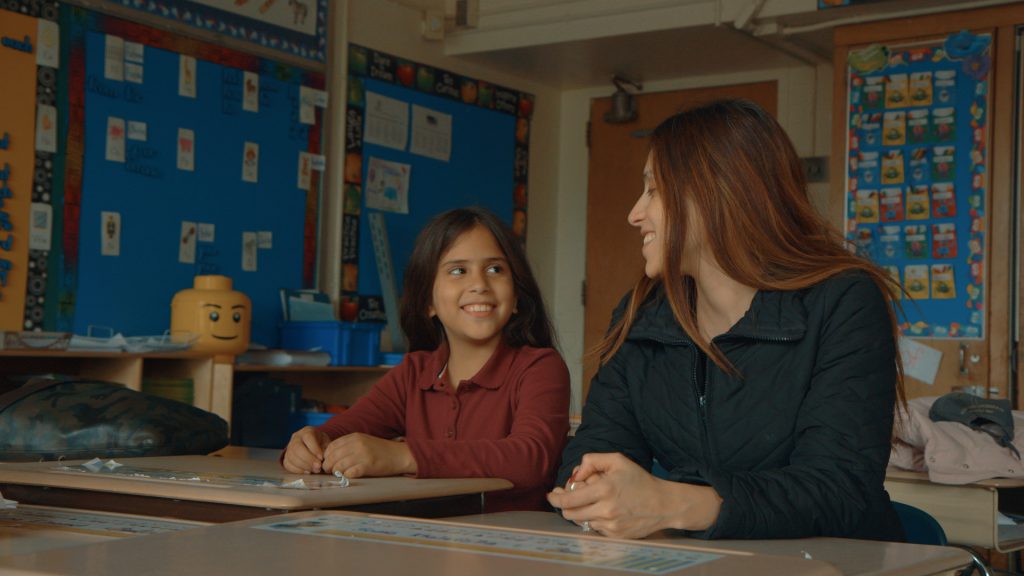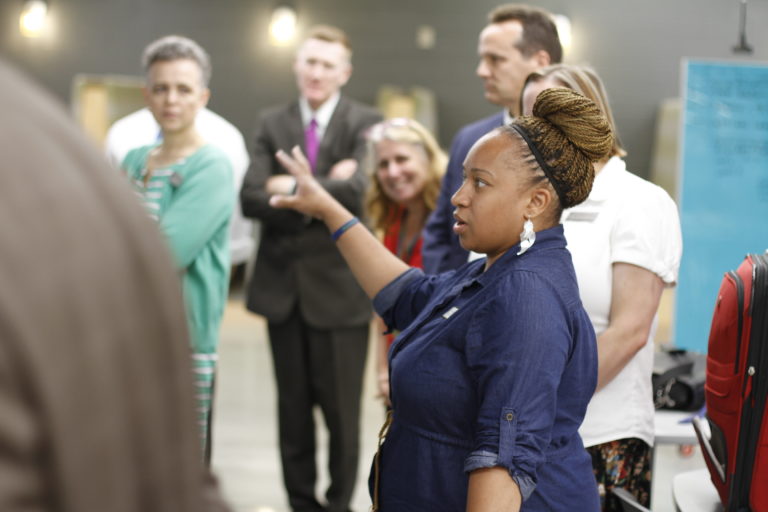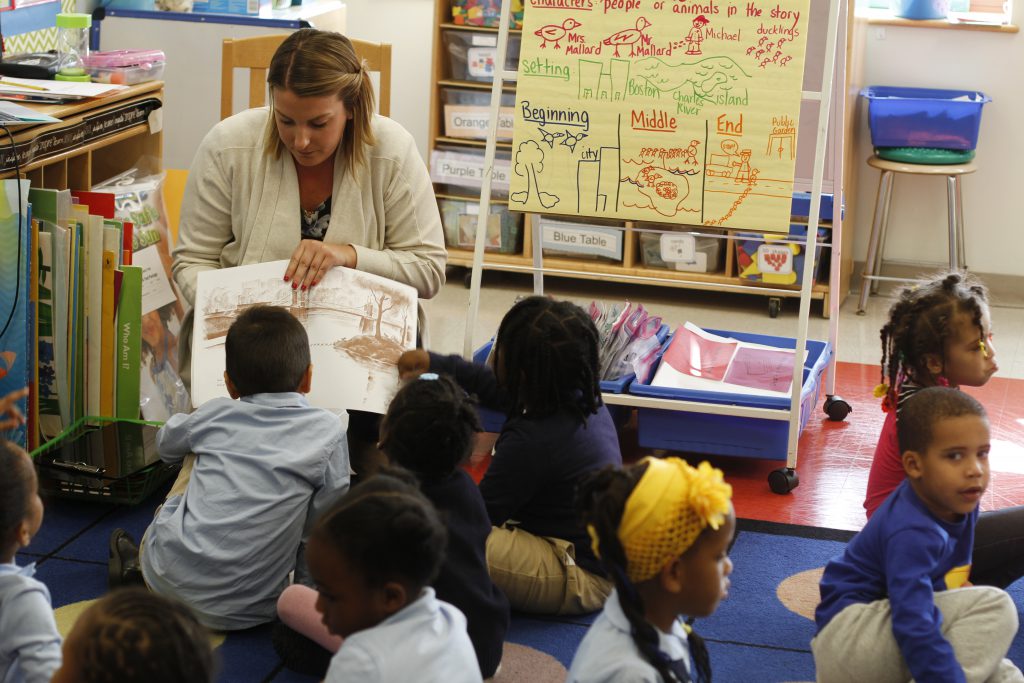What?
Reshaping the role of the teacher: from ‘content provider’ to ‘designer’.
Who?
Molly McMahon, The Teacher’s Guild.
Where?
Across the U.S.A.
The pioneer
Molly is the Director of the Teacher’s Guild and has been with it since the beginning in 2016.
She helped set up the team and then worked with them on designing programmes, continuing to lead vision and strategic growth around the Guild. She now sits at the intersection between design and business opportunities.

“We’re in a time of incredible innovation and incredibly deep divides, and our schools are at the heart of that, so teachers have to have those design skills if they want to prepare their students to be the problem solvers of tomorrow.”
The Big Change
The Teachers Guild is a non-profit initiative of PLUSSED at Riverdale Country School, New York, incubated by IDEO’s Design for Learning Studio.
It is a professional learning community for educators to develop skills in design and creative leadership. It began with the publication of the Design Thinking for Educators Toolkit, an online resource developed by IDEO in collaboration with teachers from Riverdale Country School. The Toolkit has since been downloaded over 100,000 times.
The Guild has three programme areas, including: Chapters, which aims to activate and sustain a culture of creative leadership across districts; Collaborations, an online platform which seeks to collaborate beyond schools to take on brave topics with teacher networks; and Measurement tools, which tracks individual and organisational mindset and school culture progress.

The ambition for changes
The big vision for the Teachers Guild is: for educators across the globe to become designers who lead for and from their classrooms.
This is being achieved through an online professionalised learning community and more local partnership to build leadership capability within schools and school districts.
A shift in direction
After launching the successful ‘Design Thinking For Educators’ toolkit, the Teachers Guild was established by the Head of IDEO’s Design For Learning Studio, Sandy Speicher and Head of New York’s Riverdale Country School, Dominic Randolph.
This was in response to many schools failing to address the unique and dynamic needs of students and the potential role that schools themselves can play in preparing students to be the problem solvers of tomorrow. They discussed the professional learning gaps of teachers today, what students really need and what schools could be with the help of design thinking.
“We started the Guild because there was demand for it from teachers. They were like ‘we’ve got this toolkit, what’s next, where are our other like-minded educators who are thinking this way?’”
Making change happen
1: The start point
Believing in and unlocking the potential of teachers
The Teachers Guild is underpinned by the belief that teachers are designers, rather than content providers. Molly and her team understood that the single most important driver around student learning is the teacher’s belief in their collective capacity that they can create change.
“The insight that really came out is this belief that teachers are designers – this is how IDEO and Riverdale first started working together.”
2: Taking off
Supporting vision and values with evidence
The Guild’s approach is based on adult learning theory, student learning science, academic researchers like John Hattie and best practices of teachers themselves, so teachers can experience first-hand how students can learn best. The team found that teacher collective efficacy was one of the greatest indicators of student learning. Informed by research, the Guild develops teacher collective efficacy by encouraging teachers to problem solve in groups, develop their ability to use evidence, and collaborate to understand what works and why. This has resulted in classrooms where students work together and grow socially and emotionally.
“What we do in the Guild is we lift up teacher’s belief that they have in themselves and they have in each other. We’re really focussed on teacher collective efficacy in everything we do. That’s like our North Star, and the way that we do that is really through best practices in adult learning and actually just great learning practices.”
Use engagement strategies that seek to shift mindsets of stakeholders.
Acknowledging that teachers are well placed to be agents of change, the Guild realised they could have widespread impact by shifting teachers’ mindsets, and empowering them in their ability to create change. Using an empathy-driven process, The Teachers Guild takes time to understand the needs and motivations of teachers and their classrooms. This gives teachers the opportunity to creatively problem solve and take risks, with support from The Teachers Guild community. Experiencing this process develops teachers’ ability to use empathy to identify their own student’s needs and constantly transform classroom practices.
“I think the start of anything we do is really around that mindset shift of teachers and their belief that they can create change. It’s individuals’ willingness and desire to really try new things and have a readiness for it. And you have to be able to commit to being uncomfortable and try new things, uncomfortable but also inspired, and ready to not know where that journey is going to lead you.”
3: Keeping going
Connecting and collaborating with everyday educators
Providing an online space allows teachers to come together to have brave conversations and tackle questions they care most about, whether it’s around how might you create a culture of innovation or how might they support students on their journey to and through college. The platform has been successful in helping teachers develop the capacity to model positive cultural shifts in their schools.
“If you look at what teachers do day in day out, they are always creatively problem-solving from the lens of students, whether that’s redesigning lesson plans, navigating relationships with parents and community, taking on new district initiatives – teachers are constantly having to design, for students, for families and for their districts. We created a space where they could actually peek into each other’s classrooms, build off each other’s ideas and build that muscle around getting good at trying new things and knowing if those new things work or not.”
Instill a love of learning
In order for teachers to continue to catalyse and create change, The Teachers Guild works hard to encourage their teachers to embark on a continuous learning loop by providing them with extraordinary and transformative learning experiences. Teachers then head back to their classrooms having experienced and been inspired by what learning has the potential to be.
“I think probably our biggest insight right now is just increasing our partnership between teachers and school principals, because we see relationships as the unit of change. With teachers feeling isolated and hierarchies within the school system, how do you actually open up those pathways for new types of relationships and partnerships to be formed?”
Taking change wider
Supporting school leaders to support their teachers
Transforming the role of teachers also means transforming the role of school leaders and preparing them for a new workforce. In order to best support their staff, The Teachers Guild recognise that school leaders will need to adapt their leadership as teachers play more of an active role in shaping their classroom and work across the school.
“I think probably our biggest insight right now is just increasing our partnership between teachers and school principals, because we see relationships as the unit of change. With teachers feeling isolated and hierarchies within the school system, how do you actually open up those pathways for new types of relationships and partnerships to be formed?”

The impact of change
System impact
- A focused network of 10,000 teachers in The Teachers Guild community practising design thinking and surfacing better solutions together, 90% of which are recommending the Guild.
- Over 100,000 educators have downloaded the Design Thinking for Educators Toolkit to learn about design thinking methods and mindsets.
- 95% of teacher participants believe in their ability to positively affect students and 93% design with particular students in mind.
